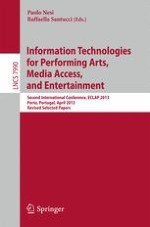This book contains revised selected papers from the Second International Conference on Information Technologies for Performing Arts, Media Access and Entertainment, ECLAP 2013, held in Porto, Portugal, in April 2013. The 24 papers presented were carefully reviewed and selected for inclusion in this book. They are organized in topical sections named: perspectives and (digital) strategies for cultural heritage institutions; trust, quality and tools for cultural heritage digital libraries; educational services for the performing arts; dance in the world of data and objects; acting and natural interaction; and music and opera of a digital generation.
